HYLES GALLII
AND EPILOBIUM ANGUSTIFOLIUM
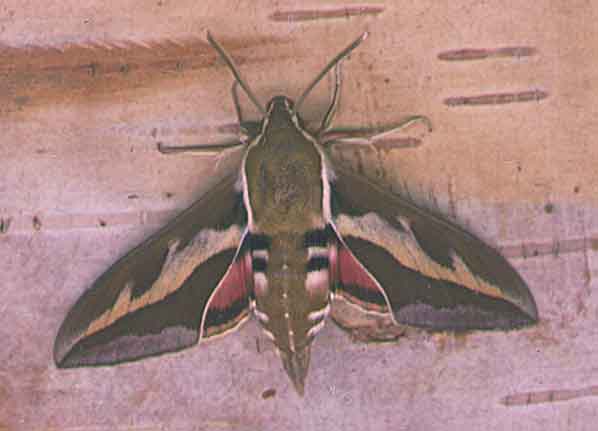
Hyles gallii scan by Bill Oehlke.
This site has been created by
Bill Oehlke at oehlkew@islandtelecom.com
Comments, suggestions and/or additional information are welcomed by Bill.
TAXONOMY:
Family: Sphingidae
Subfamily: Macroglossinae
Genus: Hyles (Hubner, 1819) was Sphinx...........
Species: gallii (Rottenburg, 1775)
|
MIDI MUSIC
.....It's a Wonderful World.....
copyright C. Odenkirk
ON.OFF
<bgsound src="world.mid" LOOP=FOREVER>
|
Hyles gallii, the Bedstraw Hawk Moth or Gallium Sphinx
(wingspan approx. 75 mm), is quite different from most of the other
Sphingidae encountered on P.E.I., Canada, in that its wings are not
scalloped, and thick line markings are relatively straight as
opposed to the thin, wavy variations characteristic of so many of
the common, local Sphingidae: P. myops, P. modesta,
P. excaecatus, C. undulosa, S. cerisyi, S. poecila.
Hyles gallii ranges
coast to coast in Canada and southward along the Rocky Mountains into
Mexico.
It is also widely distributed throughout Europe and Asia.
On July 6, 1997, at around 11:30 pm, I captured a female Gallium
Sphinx by gently
dislodging her with a pole
from her resting place about eighteen feet up on the side of a local
elementary school. I had captured two males at the same site the
previous
two evenings. The moths floated to the ground like falling leaves,
indicating they had been at the mercury vapour lights for at least
fifteen
minutes. The Bedstraw hawkmoth is single brooded throughout most of
its range with adults on the wing
from late May to early July. In more southerly regions a second
brood flies in August and September.
The female had a noticeably heavier body than the males and lacked
the claspers
which I was able to discern at the light. I put her into a brown
paper grocery
bag and folded down the top twice. She did not lay any eggs that
night.
The following night she laid approximately twenty, extremely small,
glossy,
greenish-blue eggs, and
added about fifteen more on July 8. She did not lay any eggs on
July 9 and seemed
to lack energy so I decided to feed her.
I mixed up a small solution of 1 tsp white sugar, 30 ml warm water,
and
1/4 tsp honey. After thorough mixing and allowing the mix to stand
until it cooled to room temperature, I poured some of the solution
into a small jar cap.
I gently removed the female from the bag and held her thorax at the
base of her upward-folded wings between the thumb and forefinger of
my left hand. I allowed her legs to rest on the rim of the jar cap
and inserted a pin through the proboscis coil under her head.
I carefully extended the proboscis (approximately 35mm) into the
solution. At one point I removed the pin and she recoiled her
proboscis, but then extended it again on her own into the solution.
After about five minutes of feeding I placed her in another bag.
Normally I obtain eggs from female Saturniidae and Sphingidae, by
simply placing them in fresh paper bags every two days and moving
the eggs on paper clippings to emerging jars. Since I was going
to be away for an extended period of time starting on July 9, I had
to make alternate arrangements.
I had several small patches of Epilobium angustifolium, one of
the larval food plants of Hyles gallii, growing in my yard,
so I used a garbage bag twist tie to fasten two closely growing stems
together about 8 inches from the ground. The plants were about 3.5
feet tall at this time. I used a Remay sleeve (height 4 feet,
diameter 1.2 feet) with two open ends to enclose the Epilobium.
The bottom was tied shut around the stems at the twist tie level
with a piece of cotton string. I used some thin strips of masking tape
to tape paper-egg strips to the epilobium leaf stems and then inserted the
female into the sleeve. I closed the top of the sleeve by bringing four
equidistant points to a center and then folding down the gathered cloth
in two half inch folds which were secured with two clothespins.
The weed stems, which were in a semi-sheltered, semi-shaded spot, were
sturdy enough to support the sleeve and clothespins.
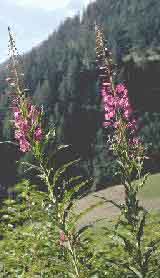
Photo courtesy of Dave Prentice, the BC Adventure Network |
Epilobium angustifolium is commonly known as fireweed
because it often grows in burnt over locales. It often gets established in disturbed sites.
It prefers full sun, but
does okay in partial shade.
The perennial plant grows from two to nine feet tall with narrow leaves
growing up to 8 inches long. Reproduction is from seed and rhizomes. Often
an entire burnt over field will begin its regeneration with an expanse of
fireweed.
In the wild females normally lay 4-5 eggs on the leaves of each host plant.
When eggs are deposited on Galium, the female will sometimes lay them on the flowers.
|
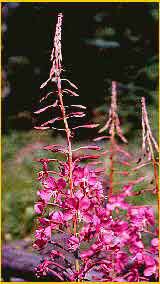
Photo courtesy of Dave Prentice, the BC Adventure Network
|
When I returned home from my trip on July 19, I checked the sleeve. There
were many small green larvae of varying sizes, several slightly larger black ones,
and a bit of food left.There is considerable variation in larval colouration and markings. Some larvae hold the green colour into final instar
while most have turned black by the second instar. | 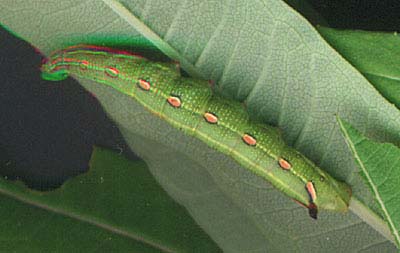
|
I quickly set up four more rearing sleeves with double stems in each and moved
all 95 larvae the following day, putting approximately twenty four to a
sleeve. These larvae were not very "clingy" and I had to be careful moving them.
With the slightest disturbance, they would let go of their leaf/stem hold
and fall to the bottom of the sleeve. Even as they grew larger, they would tend to
fall from leaves and stems when disturbed.
Larvae, which were smooth, shiny, and predominantly black, grew extremely
rapidly. They reminded me of warm, black licorice strips in that they were shiny,
long and thin, and did not seem to have or exercise much longitudinal muscle strength. | 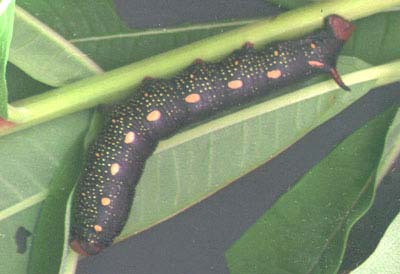 |
I moved most of these hornworm larvae indoors as they moved into their fifth instar
in about four weeks. It was far easier to gather cut food from nearby sources
and put five to six stems into five gallon containers with ten-twelve larvae/container
than it was to be constantly shifting outdoor sleeves.
Droppings and frass were removed from the buckets at least every other day.
These larvae have relatively small heads so buckets had to be kept tightly closed.
Most of the larvae left the food plant stems and began circling the bottom of the bucket
at pupation time.
I moved these larvae to similar buckets that had several layers
of loosely settled paper towels in the bottom. The larvae crawled under the upper layers and spun very flimsy
cocoons, just a few strands of silk to hold the towelling in place. A few
larvae spun similar "cocoons" in leaf wraps near the base of stems. Most larvae
had pupated within four days of moving to pupation buckets. The pupae were a tan color
with some dark brown speckling.
Eight out of ninety pupae emerged within four weeks; the others went into winter diapause
and were put into cold storage in a loosely lidded container ( I now use closed ziploc containers) in the refrigerator crisper.
I also put some damp peat moss in another lossely lidded container in the crisper to retain
high humidity.Scan to right by Bill Oehlke. | 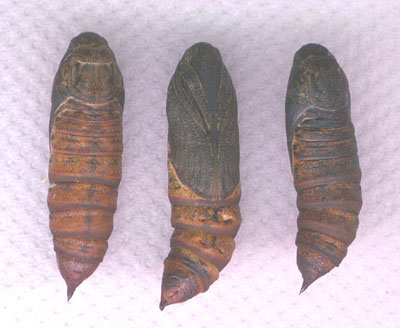 |
Once a month, pupae received a cold water bath (water chilled in crisper)
which consisted of dunking them for about two seconds into a bowl of water and then letting them air dry on some paper
towelling before going back into storage. The bath is to stimulate natural "rainy" conditions
and to prevent dessication of naked pupae.
Storage in an airtight ziploc plastic container with two drips of water on some paper towelling eliminates the need for the monthly bath.
I have often looked for gallii larvae (black with small red heads and a red horn in fifth instar) on epilobium, but have never found them. In the later instars, this species is predominantly
a night time feeder and descends the plant stem to hide in the day. Larvae progressed extremely rapidly indoors and this may have been due to the dark conditions in the tightly lidded buckets as well
as the warmer indoor temperatures.
In late June of 2000 I captured two females at lights and they deposited large numbers (100 +) of eggs in paper bags without any
feeding.
by Bill Oehlke
One of the best sites to visit for information and pictures of Sphingidae
is
Tony Pittaway's "Sphingidae of the Western Paleartic"
Please visit other websites maintained by
Bill Oehlke oehlkew@islandtelecom.com
Box 476, Peardon Road
Montague, Prince Edward Island
Canada C0A 1R0.
SATURNIIDAE OF PRINCE EDWARD ISLAND
EUROPEAN SATURNIIDAE
NORTH AMERICAN SATURNIIDAE
BUTTERFLIES OF PRINCE EDWARD ISLAND
Return to SPHINGIDAE OF PRINCE EDWARD ISLAND





